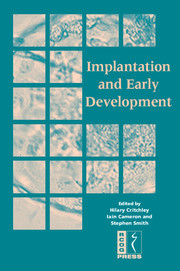Book contents
- Frontmatter
- Contents
- DECLARATION OF INTEREST
- Participants
- Preface
- SECTION 1 PREPARATION FOR IMPLANTATION – THE UTERINE ENVIRONMENT
- SECTION 2 THE EMBRYO
- SECTION 3 LESSONS FROM ANIMAL MODELS (TRANSGENICS) AND NOVEL TECHNOLOGIES
- SECTION 4 CLINICAL SEQUELAE
- 17 Sporadic early pregnancy loss: aetiology and management
- 18 Recurrent miscarriage – the role of prothrombotic disorders
- 19 Reproductive disorders and pregnancy outcome
- 20 Risk factors for first-trimester miscarriage: summary of results from the National Women's Health Study
- 21 Single-embryo transfer
- 22 Paediatric outcome after assisted reproductive technology
- SECTION 5 CONSENSUS VIEWS
- Index
22 - Paediatric outcome after assisted reproductive technology
from SECTION 4 - CLINICAL SEQUELAE
Published online by Cambridge University Press: 05 June 2014
- Frontmatter
- Contents
- DECLARATION OF INTEREST
- Participants
- Preface
- SECTION 1 PREPARATION FOR IMPLANTATION – THE UTERINE ENVIRONMENT
- SECTION 2 THE EMBRYO
- SECTION 3 LESSONS FROM ANIMAL MODELS (TRANSGENICS) AND NOVEL TECHNOLOGIES
- SECTION 4 CLINICAL SEQUELAE
- 17 Sporadic early pregnancy loss: aetiology and management
- 18 Recurrent miscarriage – the role of prothrombotic disorders
- 19 Reproductive disorders and pregnancy outcome
- 20 Risk factors for first-trimester miscarriage: summary of results from the National Women's Health Study
- 21 Single-embryo transfer
- 22 Paediatric outcome after assisted reproductive technology
- SECTION 5 CONSENSUS VIEWS
- Index
Summary
It's hardly a Darwinian way of reproducing.
DAVE, NOTTINGHAM TAXI DRIVERBefore overviewing the literature concerning paediatric follow-up of children conceived by assisted reproductive technology (ART), it is worth considering the difficulties facing researchers in this area. When trying to establish an international study of pre-implantation genetic diagnosis (PGD) outcome the author travelled around PGD centres to try to get the study under way. The vast majority of ill effects arise from the birth of children from twin, triplet, quadruplet or higher multiple pregnancies. Fifty per cent of twins are born at less than 38 weeks of gestation and at less than 2500 g. The birth rate of twins has doubled in most western countries over the past 25 years (and this is approximately 90% due to ART.)
An anecdote from one clinic visited in the USA, concerning multiple births and the relationship between a fertility team and a neonatal team, comes to mind. The head of neonates invited the fertility clinicians to visit the unit to see some of the premature babies born of higher order birth after fertility treatments. When no one visited he raised the stakes by offering to nail a silver dollar to the door frame outside the main entrance to the neonatal unit (in the style of Moby Dick.) Still no one visited. This may not represent every view but certainly represents denial.
Keywords
- Type
- Chapter
- Information
- Implantation and Early Development , pp. 268 - 280Publisher: Cambridge University PressPrint publication year: 2005



